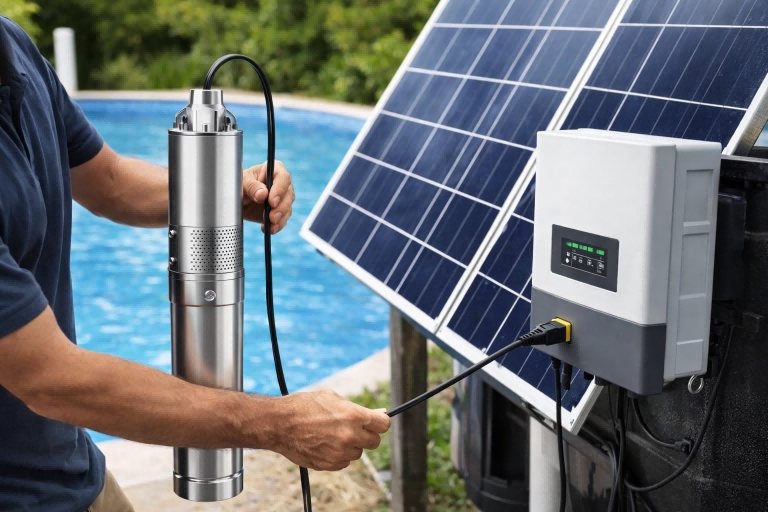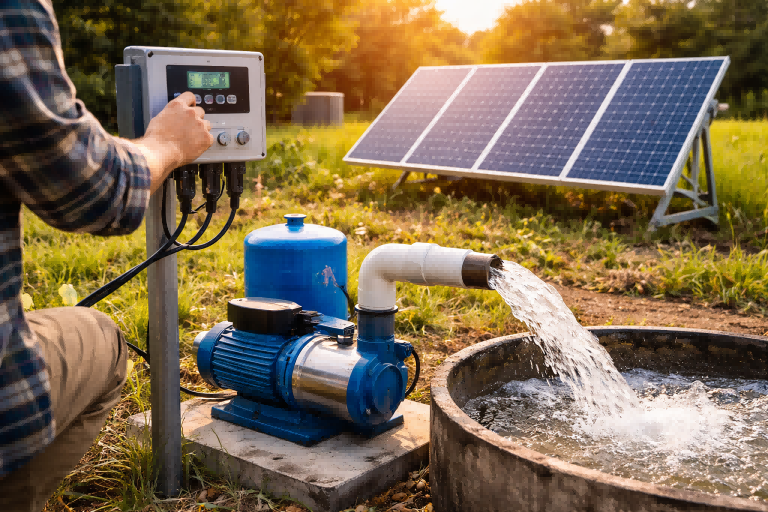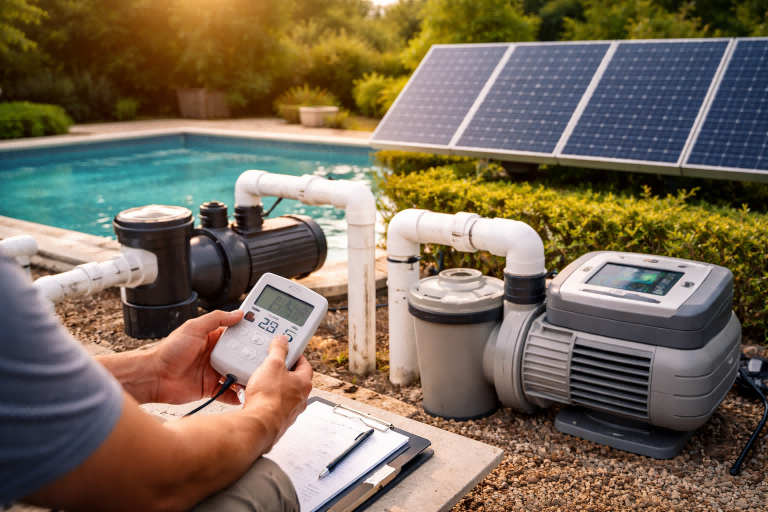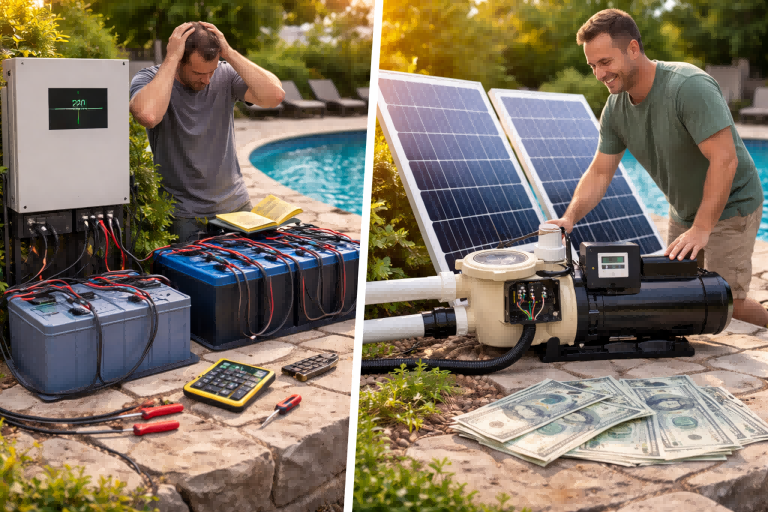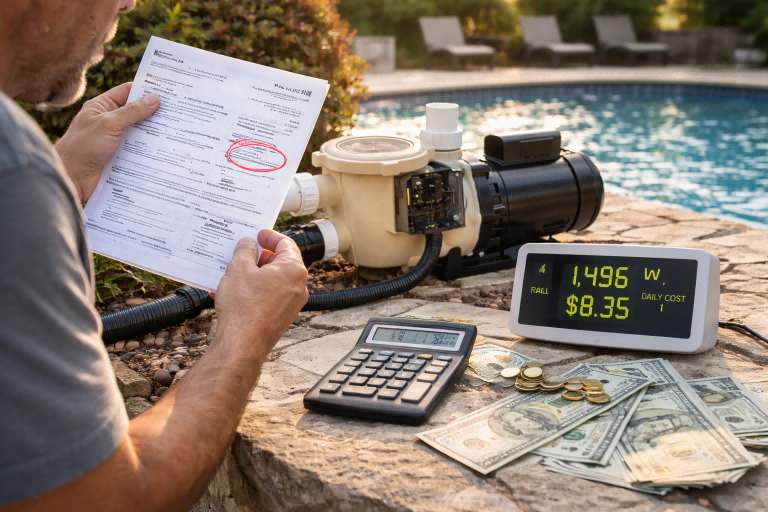Struggling to find the right pump for your water system?
A wrong choice can lead to low pressure or high energy bills, causing endless frustration.
This guide simplifies the calculation.
To calculate the water pump you need, you must determine two key figures: the required flow rate (in GPM or LPM) and the total dynamic head (in feet or meters). These figures tell you how much water you need and how far you need to move it.
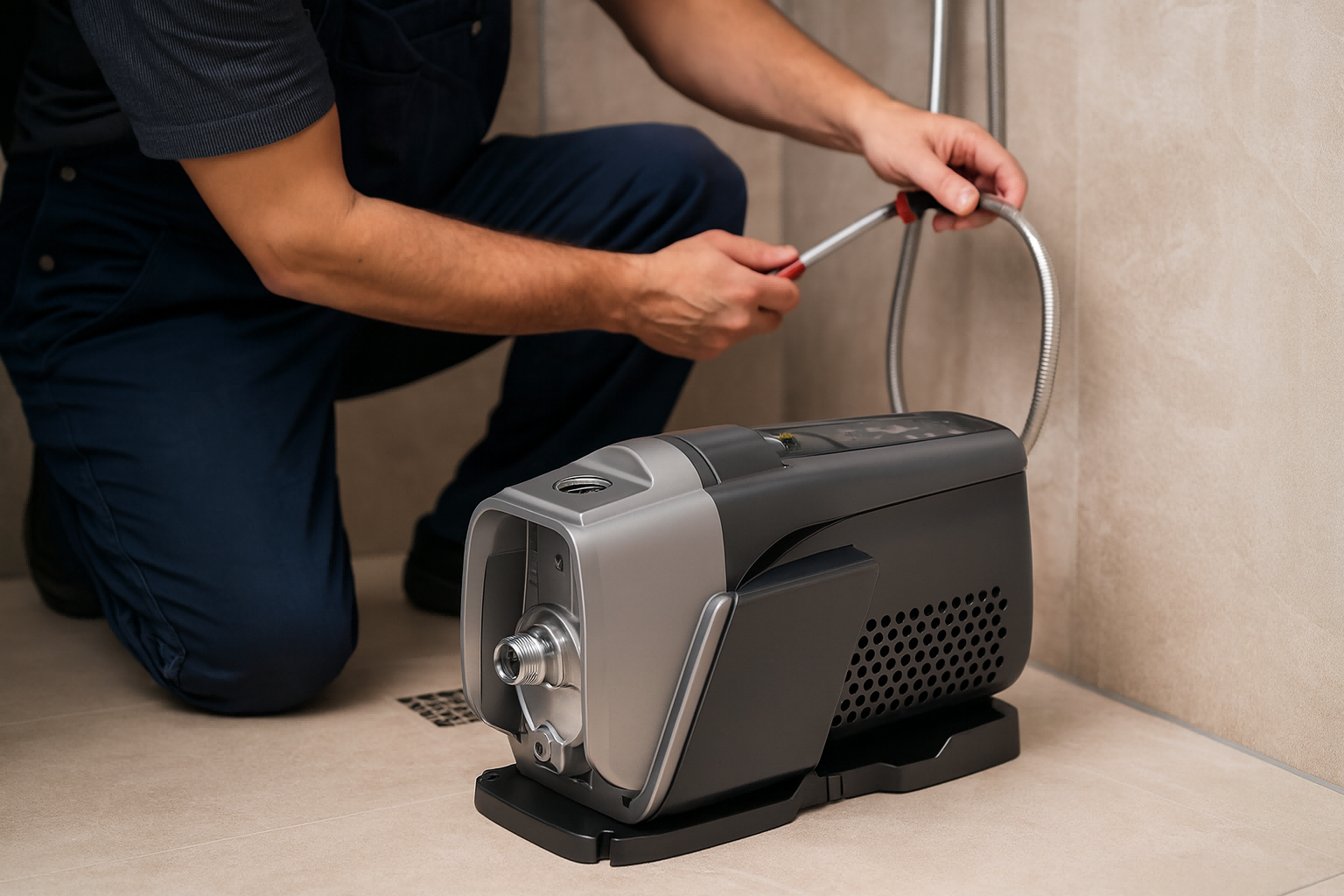
Selecting the perfect water pump can seem like a complex puzzle.
You face a wall of technical terms and formulas.
However, breaking the process down into simple, manageable steps makes it easy.
This article will walk you through each calculation, from determining your water demand to understanding pressure needs.
We will give you the confidence to choose a pump that performs perfectly for your specific application, ensuring efficiency and reliability for years to come.
Ready to master pump selection?
Let's dive in.
Understanding the Core Metrics: Flow Rate and Head
Picking a pump without knowing your flow rate and head is a recipe for failure.
This guesswork often leads to an inefficient system that wastes energy and money.
Let’s define these key terms.
Flow rate is the volume of water a pump can move in a set time, measured in Gallons Per Minute (GPM) or Liters Per Minute (LPM). Head is the maximum height the pump can lift water, accounting for elevation and friction.
Understanding flow rate and head is the absolute foundation of pump selection.
These two values dictate the performance of your entire water system.
Getting them wrong means you'll either have a pump that's too weak to do the job or one that's oversized, inefficient, and costly to run.
They work together to create what is known as a pump performance curve, a graph that shows a pump's capabilities.
Your goal is to find a pump whose performance curve matches the specific requirements of your system.
Let’s explore these two critical metrics in greater detail, so you can calculate them accurately for your needs.
What is Flow Rate?
Flow rate, or capacity, is all about volume.
It answers the question: "How much water do I need to move?"
This is arguably the first and most important variable you need to determine.
It is directly tied to the demand of your system.
For a home, this means the number of fixtures that might run simultaneously.
For an irrigation system, it's the total water needed by all the sprinkler heads.
It’s commonly expressed in units like:
- Gallons per Minute (GPM)
- Liters per Minute (LPM)
- Cubic Meters per Hour (m³/h)
What is Head?
Head is about pressure and height.
It answers the question: "How much force is needed to move the water from its source to its destination?"
It's a measurement of the vertical distance a pump can push water against gravity.
However, it's not just about simple height.
Total Dynamic Head (TDH), the most crucial figure, encompasses several factors.
Components of Total Dynamic Head (TDH)
| Component | Description | How It's Measured |
|---|---|---|
| Static Head | The total vertical distance from the water source's surface to the highest point of discharge. | Feet (ft) or Meters (m) |
| Pressure Head | The pressure required at the final destination (e.g., 40 PSI for a home). | Converted to ft or m (1 PSI ≈ 2.31 ft) |
| Friction Head | The pressure lost due to friction as water moves through pipes and fittings. | Calculated based on pipe size, length, and flow rate. |
Think of it like this: the pump must first lift the water (Static Head), then overcome resistance from the plumbing (Friction Head), and finally deliver it with enough force for use (Pressure Head).
Adding these three components together gives you the Total Dynamic Head.
Finding a pump that can provide your required flow rate at your calculated TDH is the key to a successful system.
Calculating Your Required Flow Rate (GPM/LPM)
Unsure how much water your property actually needs?
This uncertainty can lead you to buy a pump that's too small, resulting in trickling showers and poor performance.
Calculate your peak water demand first.
To calculate your required flow rate, sum the flow rates of all fixtures and appliances that could run simultaneously. This total represents your peak demand, which the pump must be able to meet. For example, a shower (2.5 GPM) plus a washing machine (2.0 GPM) requires 4.5 GPM.
Determining the right flow rate is the first practical step in sizing your pump.
This calculation ensures your pump can handle the busiest moments in your household or commercial operation.
It prevents situations where turning on a faucet causes the shower pressure to drop to an unusable level.
The process involves creating a simple inventory of your water outlets and their consumption rates.
By understanding this peak demand, you can confidently select a pump that delivers consistent and reliable water flow whenever you need it.
This section will guide you through calculating flow rate for residential, agricultural, and commercial applications.
Step 1: Identify All Water Fixtures
First, make a list of every single point where water is used.
This is a simple but crucial step.
Don't forget anything.
Your list should include items inside and outside the building.
- Indoor Fixtures: Sinks (kitchen, bathroom), showers, bathtubs, toilets, washing machines, dishwashers, water heaters, ice makers.
- Outdoor Fixtures: Garden hoses, sprinkler systems, irrigation zones, swimming pool fillers, outdoor showers.
Step 2: Find the Flow Rate for Each Fixture
Next, assign a flow rate value to each item on your list.
Many modern fixtures have their flow rate printed directly on them.
If not, you can use standard average values.
These are widely accepted industry estimates.
Average Residential Fixture Flow Rates
| Fixture | Flow Rate (GPM) | Flow Rate (LPM) |
|---|---|---|
| Bathroom Sink Faucet | 1.0 - 1.5 GPM | 3.8 - 5.7 LPM |
| Kitchen Sink Faucet | 1.5 - 2.2 GPM | 5.7 - 8.3 LPM |
| Showerhead | 2.0 - 2.5 GPM | 7.6 - 9.5 LPM |
| Bathtub Faucet | 4.0 - 7.0 GPM | 15.1 - 26.5 LPM |
| Toilet | 1.6 - 3.5 GPM | 6.0 - 13.2 LPM |
| Dishwasher | 1.5 - 2.0 GPM | 5.7 - 7.6 LPM |
| Washing Machine | 2.0 - 2.5 GPM | 7.6 - 9.5 LPM |
| Garden Hose Bib | 5.0 GPM | 18.9 LPM |
Step 3: Calculate Peak Demand
You will almost never use every single fixture at the exact same time.
The goal is to estimate the maximum realistic simultaneous usage.
This is your peak demand.
Think about a typical busy morning in your household.
Someone might be showering while the dishwasher is running and another person uses a sink.
- Example Calculation:
- 1 Showerhead: 2.5 GPM
- 1 Kitchen Sink: 2.0 GPM
- 1 Toilet Flush: 1.6 GPM
- Total Peak Demand: 2.5 + 2.0 + 1.6 = 6.1 GPM
In this scenario, you would need a pump capable of delivering at least 6.1 GPM to maintain adequate pressure for all active fixtures.
For larger homes or commercial properties, you simply expand this calculation to include all potential simultaneous uses.
For irrigation, you would sum the GPM requirements of all sprinkler heads within the largest single watering zone.
Determining the Total Dynamic Head (TDH)
Calculating head pressure seems intimidating with all its different components.
Ignoring these details could leave your pump too weak to push water to the top floor, making your investment useless.
Follow a simple three-step process.
To determine Total Dynamic Head (TDH), add three figures: 1. Static Head (vertical lift from water source to discharge), 2. Pressure Head (desired final pressure, converted to feet/meters), and 3. Friction Head (pressure lost to pipe friction). The sum is your required TDH.
After figuring out how much water you need (flow rate), the next critical step is to determine how much force is required to move it.
This force is measured as Total Dynamic Head (TDH).
It represents the total resistance your pump must overcome.
Breaking down TDH into its three core components—Static Head, Pressure Head, and Friction Head—transforms a complex engineering concept into a straightforward addition problem.
Accurately calculating TDH is non-negotiable for a properly functioning system.
Let’s walk through how to find each value and combine them to get your final number.
1. Calculate Static Head
Static Head is the easiest component to measure.
It is purely a measurement of vertical distance.
It represents the work the pump must do to overcome gravity.
There are two parts to it:
- Static Suction Lift: The vertical distance from the surface of the water source (like a well or tank) up to the pump's inlet.
- Static Discharge Head: The vertical distance from the pump's outlet up to the highest point where the water will be discharged (e.g., a second-floor showerhead).
Formula:
Static Head = Static Suction Lift + Static Discharge Head
Simply measure these two vertical heights in feet or meters and add them together.
For a submersible pump, the suction lift is zero since the pump is already in the water.
2. Determine Required Pressure Head
Your water needs to arrive at the fixture with enough pressure to be useful.
This is your desired operating pressure.
Most residential systems operate well between 40 and 60 PSI (Pounds per Square Inch).
To use this in your TDH calculation, you must convert PSI into "feet of head".
Conversion Rule:
1 PSI = 2.31 feet of head
So, if you want a minimum of 50 PSI at the highest fixture:
Pressure Head = 50 PSI * 2.31 = 115.5 feet
You will add this value to your Static Head.
This ensures the pump delivers water not just to the fixture, but with enough force to provide a strong, steady stream.
3. Estimate Friction Head (Friction Loss)
This is the most complex component, but it's crucial.
As water moves through pipes and around bends (fittings), it rubs against the surfaces, creating friction.
This friction slows the water down and reduces pressure.
The pump must work harder to overcome this loss.
Friction Head depends on four main things:
- Pipe Length: Longer pipes mean more friction.
- Pipe Diameter: Narrower pipes create significantly more friction.
- Flow Rate: The faster the water moves, the more friction it generates.
- Pipe Material & Fittings: Rougher pipes (like old iron) and more elbows/valves increase friction.
While precise calculation requires complex charts, you can use a reliable rule of thumb for initial estimates.
A common method is to calculate the total length of your pipe run (from pump to final fixture) and estimate the friction loss per 100 feet of pipe.
Simplified Friction Loss Estimation
| Pipe Diameter (PVC) | Friction Loss per 100 ft at 10 GPM |
|---|---|
| 3/4 inch | ~9.5 feet |
| 1 inch | ~2.5 feet |
| 1 1/4 inch | ~0.8 feet |
| 1 1/2 inch | ~0.4 feet |
Example Friction Head Calculation:
You have a 200-foot run of 1-inch PVC pipe and need 10 GPM.
- Loss per 100 ft is 2.5 feet.
- Total Friction Head = (200 ft / 100 ft) * 2.5 ft = 5 feet
Final TDH Calculation
Now, you just add the three components together.
- TDH = Static Head + Pressure Head + Friction Head
Example:
- Static Head = 20 ft
- Pressure Head (for 50 PSI) = 115.5 ft
- Friction Head = 5 ft
- Total Dynamic Head (TDH) = 20 + 115.5 + 5 = 140.5 feet
Your pump must be able to deliver your target flow rate (e.g., 10 GPM) at a total head of 140.5 feet.
Matching the Pump to Your Application
Choosing a pump based only on numbers can be a mistake.
A pump designed for a well is different from one made for boosting city water pressure, even if their specs look similar.
You might end up with a noisy, inefficient, or short-lived unit.
Match the pump type to its intended job. Use a submersible pump for deep wells, a jet pump for shallow wells, a booster pump to increase existing pressure, and a centrifugal pump for surface water transfer like irrigation. This ensures optimal performance and longevity.
Once you have your key numbers—flow rate and TDH—the final step is to select the right type of pump for your specific situation.
The world of pumps is diverse, with different designs excelling at different tasks.
Using the wrong type can lead to problems like cavitation (damaging air bubbles), overheating, or simply failing to perform as expected.
This selection process is about aligning the pump's design with the physical realities of your water source and delivery needs.
Let’s review the most common pump types and where they are best utilized, ensuring you make a choice that is not just powerful enough, but also perfectly suited for the job.
Common Pump Applications and Recommended Types
Different jobs call for different tools.
Water pumping is no different.
Here is a breakdown of typical scenarios and the pumps designed for them.
1. Deep Well Water Supply
- Scenario: Your water source is a well that is deeper than 25 feet (7.6 meters).
- Best Pump Type: Submersible Pump.
- Why: These pumps are designed to be submerged directly in the well water. They don't pull water; they push it up to the surface. This is far more efficient and effective for deep sources. They a re also quiet since they operate underground.
2. Shallow Well or Surface Water Transfer
- Scenario: Your water source is a shallow well (less than 25 feet deep), a lake, a river, or a storage tank.
- Best Pump Type: Jet Pump or Centrifugal Pump.
- Why:
- Jet Pumps are mounted above ground and use suction to pull water from the source. They are a reliable and cost-effective choice for shallow depths.
- Centrifugal Pumps are great for moving large volumes of water at relatively low pressure. They are ideal for irrigation or transferring water between tanks.
3. Boosting City Water Pressure
- Scenario: You have adequate water supply from the city, but the pressure in your home or building is too low.
- Best Pump Type: Booster Pump.
- Why: These pumps are installed on your existing plumbing line. They take the incoming pressure and increase it to your desired level. They don't create flow, they amplify pressure.
4. Constant Pressure Systems
- Scenario: You need consistent, unwavering water pressure regardless of how many taps are open. This is crucial for luxury homes, commercial buildings, and sensitive industrial processes.
- Best Pump Type: Variable Speed Drive (VSD) Booster Pump.
- Why: A VSD pump, also called an inverter booster pump, is a "smart" pump. Instead of running at full speed all the time, it adjusts its motor speed in real-time to match the water demand. This provides perfectly constant pressure, is extremely energy-efficient (saving up to 50% on electricity), and operates very quietly.
Pump Application Summary Table
| Application | Water Source Depth | Primary Goal | Recommended Pump | Key Advantage |
|---|---|---|---|---|
| Household Well | > 25 feet (Deep) | Primary water supply | Submersible | Pushes water efficiently from deep sources |
| Household Well | < 25 feet (Shallow) | Primary water supply | Jet Pump | Reliable suction for shallow depths |
| Low City Pressure | N/A | Increase pressure | Booster Pump | Amplifies existing water line pressure |
| Irrigation/Transfer | Surface (Tank, Lake) | Move high volume | Centrifugal Pump | High flow rate at lower pressure |
| Premium Residential/Commercial | Any | Maintain constant pressure & save energy | VSD Booster Pump | Intelligent pressure control, energy savings |
By matching the pump's design to your application, you guarantee not only that it will work, but that it will work efficiently and reliably for its entire service life.
Why Pump Efficiency and Power Source Matter
You have your numbers, but choosing the cheapest pump that meets them is a common pitfall.
This short-term saving often turns into long-term expense through sky-high electricity bills and frequent maintenance.
A cheap pump works much harder, wasting energy.
Consider the pump's efficiency and power requirements. A high-efficiency pump, like a Variable Speed Drive (VSD) model, uses significantly less electricity to perform the same work, leading to substantial long-term cost savings and a longer lifespan for the equipment.
The final piece of the puzzle goes beyond just flow and head.
It's about the long-term operational cost and sustainability of your water system.
A pump is a machine that will be running for years, and its energy consumption is a major part of its total cost of ownership.
Furthermore, ensuring you have the correct power supply is a basic requirement for the pump to function at all.
Modern pump technology, particularly VSD systems, has revolutionized efficiency.
Understanding these factors allows you to make an investment that is not only powerful and reliable but also smart and economical.
Understanding Pump Efficiency
A pump's job is to convert electrical energy into water pressure (mechanical energy).
No pump is 100% efficient; some energy is always lost as heat and noise.
Pump efficiency is the ratio of the work done moving water to the electrical energy consumed.
A more efficient pump does the same job using less electricity.
- Standard Pumps: Operate at a fixed speed. They are either ON (at 100% power) or OFF. This is inefficient when water demand is low, as they are still running at full tilt, wasting immense amounts of energy.
- High-Efficiency VSD Pumps: These intelligent pumps use a variable frequency drive to adjust the motor's speed. If demand is low (e.g., only one faucet is open), the pump slows down, consuming just enough power to meet the need. This results in massive energy savings.
The Financial Impact of Efficiency
| Pump Type | Energy Consumption | Estimated Annual Cost (at $0.15/kWh) | Long-Term Benefit |
|---|---|---|---|
| Standard Fixed-Speed Pump | High, constant consumption | $400 | Low initial cost |
| RAFSUN VSD Booster Pump | Variable, matches demand | $200 (or less) | Up to 50%+ energy savings, lower lifetime cost |
Choosing a VSD pump is a strategic business decision for distributors and a smart investment for end-users.
The energy savings often pay back the initial higher cost of the pump within a short period.
Check Your Power Source
This may seem obvious, but it is a critical final check.
Pumps are designed to run on specific electrical supplies.
Mismatching the pump to the power source will, at best, prevent it from working and, at worst, permanently damage the motor.
Key Power Specifications to Check:
- Voltage: Is your supply 110V, 220V, or something else? Ensure the pump's voltage rating matches your available power. Many modern pumps support dual voltage, but you must check.
- Phase: Residential power is typically single-phase. Larger commercial or industrial applications often use three-phase power, which is more efficient for powerful motors. You must match the pump to the phase of your electrical system.
- Amperage (Amps): The pump will have a "Full Load Amps" (FLA) rating. Your electrical circuit must have a breaker or fuse rated to handle this current draw safely. Using an undersized circuit is a fire hazard.
Before you finalize your purchase, confirm your available power supply.
Consulting with an electrician is always the best practice if you are unsure about any of these specifications.
This ensures a safe, successful installation.
Conclusion
Calculating your pump needs is a process of defining flow rate and total head.
Matching these numbers to the right pump type ensures a reliable and efficient system.
FAQs
What is the difference between a booster pump and a VSD pump?
A standard booster pump runs at a fixed speed to increase pressure. A VSD (Variable Speed Drive) booster pump is a smart pump that adjusts its speed to maintain constant pressure, saving energy.
How do I size a pump for irrigation?
To size an irrigation pump, calculate the total GPM needed for the largest watering zone. Then, determine the Total Dynamic Head, including lift, pressure for sprinkler heads (PSI), and friction loss through the pipes.
Can I use a pump that is too big?
Using an oversized pump is a bad idea. It will waste a significant amount of electricity, cycle on and off too frequently (causing premature wear), and can even damage your plumbing system.
How does pipe size affect my pump choice?
Smaller pipes create more friction loss for the same flow rate. If you use undersized pipes, you will need a more powerful (and expensive) pump to overcome this extra resistance.
What does "priming a pump" mean?
Priming means filling the pump casing and suction line with water before starting it. Above-ground pumps like jet pumps need to be primed to create suction; submersible pumps do not.
How long should a good quality water pump last?
A well-maintained, high-quality residential water pump, such as a VSD booster pump, can last from 8 to 15 years. Longevity depends on usage, water quality, and regular maintenance.


